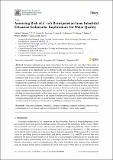Files in this item
Assessing risk of E. coli resuspension from intertidal estuarine sediments : implications for water quality
Item metadata
| dc.contributor.author | Wyness, Adam James | |
| dc.contributor.author | Paterson, David Maxwell | |
| dc.contributor.author | Rimmer, James | |
| dc.contributor.author | Defew, Emma Clare | |
| dc.contributor.author | Stuttter, Marc I | |
| dc.contributor.author | Avery, Lisa M | |
| dc.date.accessioned | 2019-09-05T08:30:06Z | |
| dc.date.available | 2019-09-05T08:30:06Z | |
| dc.date.issued | 2019-09-05 | |
| dc.identifier | 260991186 | |
| dc.identifier | c585593b-689a-4d0f-bbdf-279f764c127c | |
| dc.identifier | 85071965394 | |
| dc.identifier | 000489178500029 | |
| dc.identifier.citation | Wyness , A J , Paterson , D M , Rimmer , J , Defew , E C , Stuttter , M I & Avery , L M 2019 , ' Assessing risk of E. coli resuspension from intertidal estuarine sediments : implications for water quality ' , International Journal of Environmental Research and Public Health , vol. 16 , no. 18 , 3255 . https://doi.org/10.3390/ijerph16183255 | en |
| dc.identifier.issn | 1660-4601 | |
| dc.identifier.other | ORCID: /0000-0003-1174-6476/work/61370008 | |
| dc.identifier.uri | https://hdl.handle.net/10023/18423 | |
| dc.description | Funding: University of St Andrews, and The James Hutton Institute. DMP received funding from the Marine Alliance for Science and Technology for Scotland (MASTS), funded by the Scottish Funding Council (grant reference HR09011). | en |
| dc.description.abstract | Estuarine sediments are a reservoir for faecal bacteria, such as E. coli, where they reside at greater concentrations and for longer periods than in the overlying water. Faecal bacteria in sediments do not usually pose significant risk to human health until resuspended into the water column, where transmission routes to humans are facilitated. The erosion resistance and corresponding E. coli loading of intertidal estuarine sediments was monitored in two Scottish estuaries to identify sediments that posed a risk of resuspending large amounts of E. coli. In addition, models were constructed in an attempt to identify sediment characteristics leading to higher erosion resistance. Sediments that exhibited low erosion resistance and a high E. coli loading occurred in the upper- and mid-reaches of the estuaries where sediments had higher organic content and smaller particle sizes, and arose predominantly during winter and autumn, with some incidences during summer. Models using sediment characteristics explained 57.2% and 35.7% of sediment shear strength and surface stability variance respectively, with organic matter content and season being important factors for both. However large proportions of the variance remained unexplained. Sediments that posed a risk of resuspending high amounts of faecal bacteria could be characterised by season and sediment type, and this should be considered in the future modelling of bathing water quality. | |
| dc.format.extent | 13 | |
| dc.format.extent | 2478288 | |
| dc.language.iso | eng | |
| dc.relation.ispartof | International Journal of Environmental Research and Public Health | en |
| dc.subject | Estuarine sediment | en |
| dc.subject | Intertidal | en |
| dc.subject | Cohesive sediment | en |
| dc.subject | Sediment stability | en |
| dc.subject | Erosion | en |
| dc.subject | Faecal contamination | en |
| dc.subject | E. coli | en |
| dc.subject | Faecal indicator organism (FIO) | en |
| dc.subject | Bathing waters | en |
| dc.subject | Water quality | en |
| dc.subject | QR Microbiology | en |
| dc.subject | RA0421 Public health. Hygiene. Preventive Medicine | en |
| dc.subject | NDAS | en |
| dc.subject | SDG 3 - Good Health and Well-being | en |
| dc.subject.lcc | QR | en |
| dc.subject.lcc | RA0421 | en |
| dc.title | Assessing risk of E. coli resuspension from intertidal estuarine sediments : implications for water quality | en |
| dc.type | Journal article | en |
| dc.contributor.institution | University of St Andrews. Coastal Resources Management Group | en |
| dc.contributor.institution | University of St Andrews. Sediment Ecology Research Group | en |
| dc.contributor.institution | University of St Andrews. Marine Alliance for Science & Technology Scotland | en |
| dc.contributor.institution | University of St Andrews. Scottish Oceans Institute | en |
| dc.contributor.institution | University of St Andrews. St Andrews Sustainability Institute | en |
| dc.contributor.institution | University of St Andrews. School of Biology | en |
| dc.identifier.doi | https://doi.org/10.3390/ijerph16183255 | |
| dc.description.status | Peer reviewed | en |
| dc.identifier.url | https://www.mdpi.com/1660-4601/16/18/3255/s1 | en |
This item appears in the following Collection(s)
Items in the St Andrews Research Repository are protected by copyright, with all rights reserved, unless otherwise indicated.

